Braids can make a look or break a look, but they mostly break a look when you have build-up. They’re also a great way of protecting your hair from harsh outside temperatures, but the protection fades away when the build-up is accumulated in them.
But what causes build-up in braids?
The longer you have the braids, the more build-up your braids have. Build-ups result from dirt, debris, dead skin cells, lint, natural hair oil, and hair products accumulating on your scalp.
Doing your braids can be pretty daunting, but taking care of them once they’re done can be more challenging. Build-ups can be quickly dealt with little hard work and patience.
Let’s see how.
What is Buildup in Braids
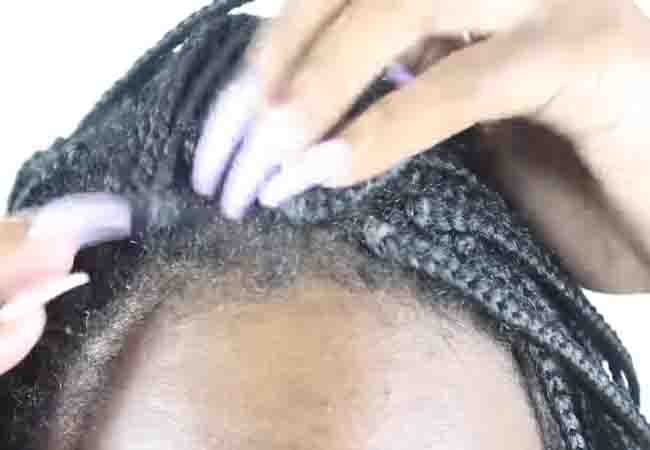
Build-ups can be pretty frustrating and hard to deal with. But what are they? And why do they happen? Here’s the answer:
- Our hair and scalp become coated in a mixture of natural sebum (secreted by our scalp), the products we use daily, and dust or dirt from our environment, which is the leading cause of build-up.
- To keep your scalp healthy, clean up the build-up regularly. The interval at which your scalp needs to be cleaned depends on the health of your scalp and the time it takes for your hair to get oily.
- Build-ups are of two main types: natural and product build-up. Dead skin cells in your scalp, dirt, and sebum create natural build-up, especially if you don’t wash your hair regularly.
- Styling gel, mousse, hair spray, and even some other hair cleaning and moisturizing products get stuck to your hair, becoming visible as product build-up.
- Your hair doesn’t have build-up only when it is in a braid. Residues of build-ups can be seen even after you take your braids out.
- Most people become familiar with build-ups when they try to style their hair in braids or when they take out the braids. Focus on your scalp or at the position where your braid comes in contact with your hair because these are where most of your build-ups occur.
- Due to the build-up, your hair becomes oily and gets tangled. This makes it harder to wash your hair and even causes it to shed.
- The dirt, lint, or oil built up on your head can cause your head to smell unpleasant.
What Does Product Build-up Look Like
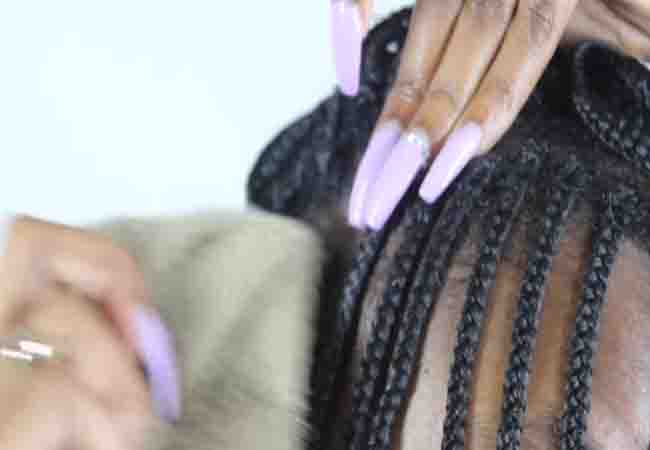
Build-up from products occurs when you don’t properly clean your scalp after using them. They slowly accumulate on your scalp and become hard to remove. Product build-ups –
- Look like a cotton ball.
- Are whiteish in color and develop around the start of the braids.
Does Build-up Damage Hair
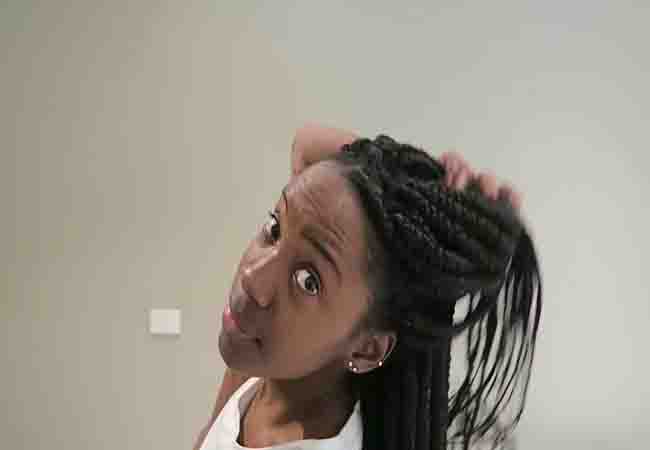
Build-ups can be the cause of several hair-related issues that severely damage the hair and scalp. These include but are not limited to:
- Buildup prevents your hair from getting the necessary nutrition.
- The type of buildup in your hair doesn’t matter. What matters is that it can cause inflammation. This leads to flakiness and itching, making your scalp tender and ache.
- People tend to scratch a lot when there is a build-up in their scalps. Not getting a cure for it increases the itching and causes the scalp to flake excessively.
- When build-up forms on an oily scalp, it’s more likely to be inflamed and painful, similar to having a pimple.
- Excessive build-up suffocates the follicles in your root and even pulls the hair down as the surroundings of the follicles get inflamed.
- Product buildup leads to chronic hair loss. Alongside, dead skin cells, oil, and sweat can clog the follicle openings and prevent hair growth.
- Excessive build-up can force you to cut your hair.
A build-up in braids can result in the
- Itchiness of the scalp
- The Scalp becomes flaky
- Dandruff
- Twists
- Unclean braids
- Hair fall
Maintain Healthy Braids
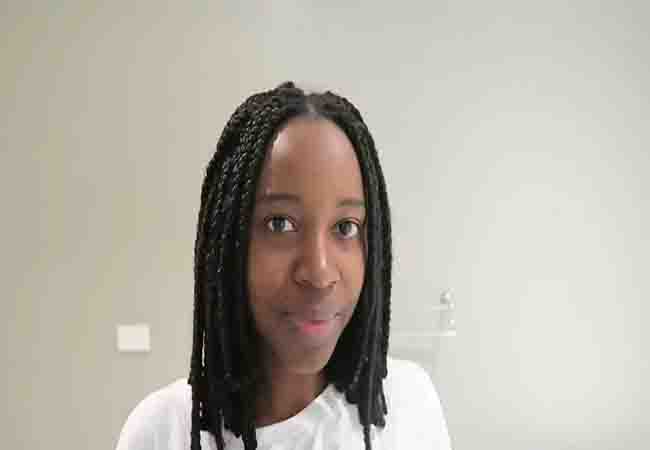
In order to keep your braids healthy and to keep them for longer, do the following:
- Prepping for Braids: Make sure your hair is clean and free of any hair products before installing braids.
- Maintaining a Healthy Scalp: Taking the necessary steps to ensure your scalp is healthy while you have the braids on is vital.
- Hydrating and Oiling Your Scalp: Try to hydrate and oil your scalp.
- Limiting Product Use: Avoid using too many products.
- Avoiding Excessive Wetting: Avoid wetting your braids, as wet hair is more likely to get tangled.
- Protecting Your Braids at Night: To protect your hair at night, wrap your braids in a satin or silk scarf.
- Avoiding Continuous Braiding: Please don’t keep your hair always braided, as it causes more breakage.
- Minimizing Heat Styling: Heat styling tools can damage your scalp and hair so try to use them as little as possible.
- Regularly Refreshing Your Braids: Make sure your braids are regularly touched to look fresh and healthy.
What Causes Buildups in Braids
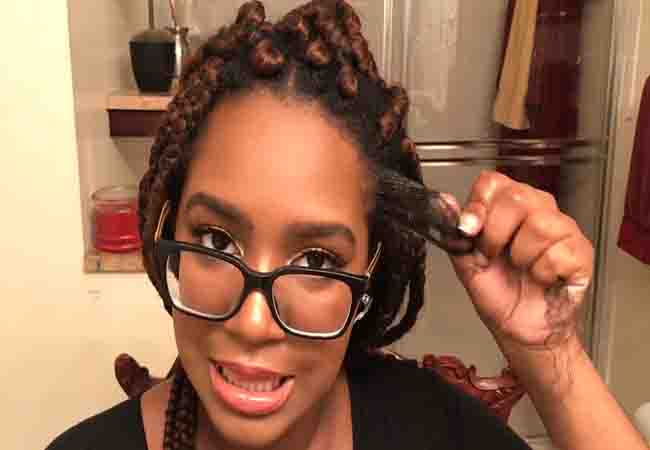
Build-ups on your scalp can occur due to a lot of reasons. While these can all be prevented, it’s better to still know about them:
- Keeping your braids in more than the recommended duration can cause build-up too. A build-up in braids is caused by waste and litter, usually formed by the natural oil produced by the scalp and various products used to take care of the braid.
- Using products like these, not correctly moisturizing your scalp, and not cleaning your scalp regularly can result in the build-up. If a braid is kept for ten weeks or longer, matting occurs at the roots, and there are many build-ups. Those who keep their extensions braided for an extended period usually get oily and mucky buildup.
- Failure to correctly wash or dry leads to molds and build-up. If the hair is not dried properly after a wash, it’ll remain dew, and the chances of a build-up will be higher. If the braid is constantly wet, there’s a chance of it getting tangled and causing a build-up.
- Applying hair care products on the scalp and not removing them before braids is the first step to causing a buildup.
- Again, hair care products themselves cause buildup by creating a layer (they are usually stickier to stick to the hair for better care)
- Insistence on shampooing the hair while it is braided
- Heavy hair products like heavy moisturizers or stylers can cause excessive buildup.
- It is often thought that dry shampoo products help liven the hair. However, it leads to even more build-up.
How to Prevent Braid Buildup
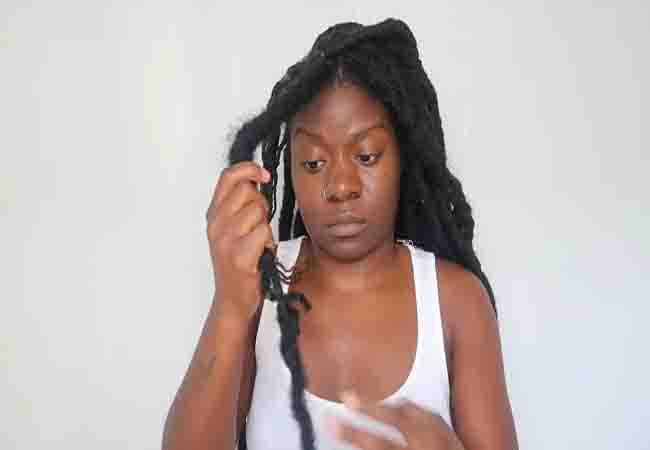
This can be a lengthy process. Moreover, removing the braid and the build-up without causing breakage to the hair can be challenging.
1. Use Fewer Styling Products
The first step is to lessen the amount of hair product use. Water-based hair care products could be used instead.
Cream or silicon-infused products should be used as little as possible because gels and mousses regularly can cause hair to get tangled, which is hard to get rid of.
2. Cleaning Hair With A Fine Tooth Comb
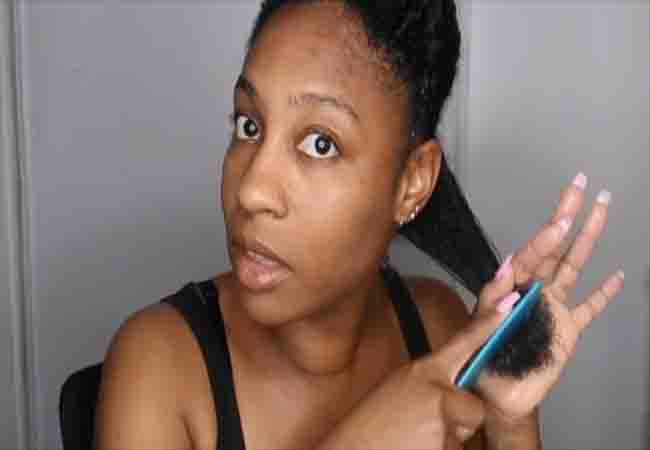
Fine-tooth combs work wonders when it comes to removing extra dandruff or build-up from your hair and scalp.
3. Cleanse The Scalp Regularly
- Clean and wash braids and comb your hair and scalp when you see build-up. Ensuring your scalp is clean is essential.
- Mix a clarifying shampoo, and some water in a wash bottle and apply, as it helps the product reach the roots and also helps restore the proper pH balance.
- Massage the scalp in gentle circular motions to reduce buildup. This may take a while.
4. Wash Your Braids
- It’s necessary to reduce buildup before washing or moisturizing the hair. The amount of buildup should be taken into account as excessive buildup will act as a block to any remedies you use – it’ll be less effective and thus a waste of money.
- If you have dandruff or any other problem that is leading to oil build-up or flaking, the only way to get rid of buildup, in that case, is to wash the braid.
- As per stylists, to keep the hair and the braid healthy, wash the braid every two to three weeks as too much build-up from sebum, sweat, dead skin cells, and products stops the scalp from breathing.
- It’s necessary to be gentle on the scalp while washing braided hair. If not handled gently, it might cause more damage to the hair.
5. Use Antiseptic Products
- Mix ingredients like zinc, peppermint oil, tea tree oil, saw palmetto, burdock, nettle, ginger, and Vitamin E with the TRU-Balance Hair care scalp care system as its antiseptic properties would help reduce bacteria and buildup.
- Use astringents like Sea Breeze or Witch Hazel when your braids need cleansing from all the build-up and dirt.
- Light oils such as Jojoba oil can help reduce the solid-like products from your roots.
- Baking soda is another multi-purpose household item that can remove buildup naturally. Mix a tablespoon of baking soda with your usual amount of shampoo, and then wash your hair.
6. Can I Soak My Braids in Vinegar?
If you want to avoid washing your braids regularly, apple cider vinegar can help reduce buildup. This is a good alternative, especially for those with itchiness of the scalp
People worry about how vinegar smells, but the smell disappears when the vinegar dries up. Vinegar is a fantastic way to get rid of your build-ups.
7. How Does Apple Cider Vinegar Help Remove Buildup from Braids
- Dilute the vinegar with water before applying it. Undiluted vinegar will ruin the dew in your hair and burn your scalp.
- Apple cider vinegar has anti-bacterial, anti-inflammatory, and anti-fungal properties which keep the scalp clean, reducing itching and dandruff.
- Apple cider vinegar works like a clarifying shampoo.
Causes of Dandruff in Braids: How Do I Stop Dandruff in My Braids
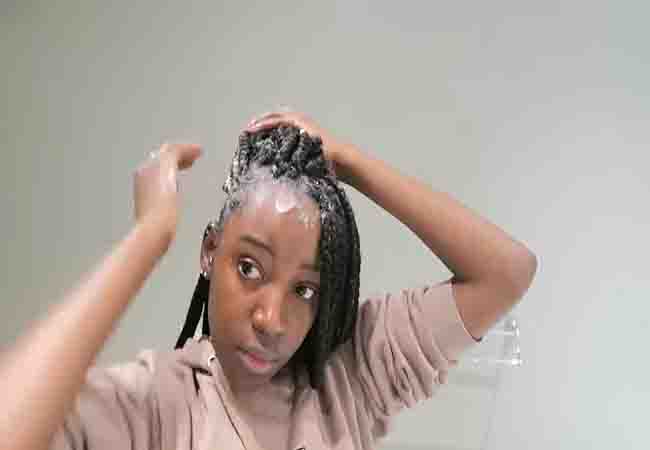
- It’s often said that dandruff occurs from a fungus called Malassezia.
- Dandruff is a frequently occurring issue seen as white flakes in your hair and clothes. Although it’s not harmful, it can be pretty annoying and unsightly.
- Braids, weaves, and sew-ins can cause dandruff, but it’s possible to get dandruff without them.
- An itchy, flaky, dry, greasy scalp causes dandruff too. Hair creates white flakes because it’s either dry or it’s greasy. It should be dried properly to reduce dandruff.
- Conditioning masks prevent the formation of dandruff. It ensures your hair isn’t dry by keeping it hydrated.
- Apply peppermint oil, Lavender oil, Tea tree oil, Jojoba oil, or anti-dandruff shampoo where you spot flakes.
Should I Oil My Braids Daily
It’s optional to oil your braids daily. Applying excessive oil can lead to buildup and other problems. Oil it one or two times per week, depending on the hair type and braid.
Oiling it twice is more helpful. If your braids feel dry or damaged, then oil them regularly. But if you have an oily scalp or are prone to build-up, oil it less frequently.
Do Not Leave Your Braids: How Long Should You Keep Your Braids in
How long a braid will last depends on the hair type, but the benchmark is a month.
It’ll be hard to take a braid off if it is kept on for more than four weeks with product buildup and hair fall.
FAQs
Lavender, peppermint, or castor oil are essential oils that can be used to treat bumps. Their anti-inflammatory and antibacterial properties help ease scalp tightness.
A hairstyle like sewn-in braids for too long will cause a buildup of hair shed.
Take your time and gently use a fine tooth comb to maneuver between the braids to get rid of dirt buildup.
To get rid of buildup without washing dreads, you can use a residue-free clarifying spray or a dry shampoo specifically formulated for dreadlocks. Apply it to the roots and massage it in, then use a clean cloth or towel to wipe away the residue.
To remove buildup from a protective style, you can use a clarifying shampoo diluted with water and gently massage it onto your scalp and hair. Rinse thoroughly and follow up with a deep conditioner to moisturize your hair.
To untangle matted hair after braids, you can use a detangling spray or apply a moisturizing conditioner to soften the hair. Using a wide-toothed comb or your fingers, gently separate the tangles starting from the ends.
To remove styling product buildup from hair, you can use a clarifying shampoo or a vinegar rinse. Mix equal parts of water and apple cider vinegar, apply it to your hair, and rinse thoroughly. Follow up with a moisturizing conditioner.
Product buildup in hair may appear as a white or grayish film on the scalp and hair shafts. It can make the hair feel heavy, greasy, and difficult to style.
To prevent product buildup in braids, avoid using heavy, greasy products and use lightweight, water-based products instead. Also, make sure to thoroughly rinse out any products when washing your hair and avoid applying products directly to the scalp.
It’s time to take your braids out when you start experiencing discomfort, itching, or pain, or when your natural hair starts to grow out significantly and the braids become too loose or heavy.
Losing some hair after braids is normal due to shedding, but if you are experiencing excessive hair loss, it may be due to tight braids or improper installation. Loosening the braids and gently detangling your hair can help reduce hair loss.
Conditioner can help to some extent in removing mild product buildup from hair, but a clarifying shampoo or vinegar rinse may be more effective for heavy buildup.
Seeing hair follicles in braids is normal and indicates new hair growth. It’s not necessarily a cause for concern.
It’s generally recommended to do a protein treatment after braids to strengthen the hair and replenish any lost protein.
Hair may become matted after braids due to the natural shedding and regrowth of hair, as well as friction and tangling caused by the braids. Proper detangling techniques and regular moisturizing can help prevent matting.
Dandruff after braids may be due to dry scalp or buildup of dead skin cells. Regularly massaging your scalp with an oil or applying a medicated dandruff shampoo can help address the issue.
Braids may become crusty if too much product is used or if the hair is not properly cleaned and moisturized. Proper hair care and using lightweight products can help prevent crustiness.
To keep white flakes out of braids, make sure to thoroughly cleanse your scalp before installing the braids and avoid using heavy or greasy products that can cause buildup.
Bumps from braids may go away on their own, but if they persist, it may indicate an allergic reaction, infection, or other underlying issue. Consult a dermatologist for proper diagnosis and treatment.
Product buildup in braids may appear as a greasy, sticky, or dull residue on the scalp and hair shafts. It can make the braids feel heavy and uncomfortable.
Not giving your hair a break from braids can cause tension on the hair shafts and scalp, leading to hair breakage, thin edges, and other issues. It’s important to allow your hair and scalp to rest in between protective styles to promote healthy hair growth.
Apple cider vinegar can help remove product buildup in hair due to its acidic properties. Mix equal parts of water and apple cider vinegar, apply it to your hair, and rinse thoroughly. Follow up with a moisturizing conditioner.
White bumps from braids may be caused by a condition called folliculitis, which is inflammation of the hair follicles. It can occur due to bacterial or fungal infections, or from irritation caused by tight braids. Proper hygiene, avoiding tight braids, and seeking medical attention if the bumps persist can help resolve the issue.
White flakes on braids may be caused by dry scalp or dandruff. Regularly massaging your scalp with an oil or using a medicated dandruff shampoo can help reduce the flakes.
Product buildup in hair is caused by the accumulation of styling products, oils, and other debris on the scalp and hair shafts. It can lead to dullness, heaviness, and other hair issues if not properly addressed.
It’s recommended to give your hair a break from protective styles to avoid tension, breakage, and scalp issues. Ideally, you should let your hair breathe and rest for at least a few weeks between protective styles.
Hair shedding is a normal part of the hair growth cycle, and protective styles like braids or weaves can cause accumulated shed hairs to be released all at once when the style is removed, giving the appearance of a large amount of hair coming out.
It’s generally recommended to let your hair “breathe” or rest for at least 1-2 weeks between protective styles to avoid potential damage and allow your scalp and hair to recover.
Keeping braids in for more than 8-10 weeks can increase the risk of hair damage, breakage, and scalp issues, so it’s generally advised not to exceed this timeframe.
Wearing your hair in a loose bun, braid, or twist, or using a satin/silk bonnet or pillowcase to protect your hair while sleeping can be considered healthy protective styles for bedtime.
Tight protective styles can cause hair loss due to the constant tension on the hair shafts and scalp. Avoiding excessively tight styles, using proper installation techniques, and taking breaks in between styles can help prevent hair loss.
In between protective styles, you can practice good hair care habits such as regular cleansing, conditioning, and moisturizing. You can also wear low-manipulation styles that do not cause tension or stress on the hair.
The frequency of redoing braids depends on various factors such as your hair type, the type of braids, and your lifestyle. Generally, it’s recommended to redo braids every 6-8 weeks to prevent tension and damage to the hair.
Leaving box braids in for too long can cause tension on the hair shafts and scalp, leading to hair breakage, thin edges, and other issues. It’s best to follow the recommended timeframe for your specific type of braids and avoid keeping them in for extended periods of time.
Braids themselves do not promote hair growth, but they can protect the hair from damage and manipulation, which may help to retain length and promote healthy hair growth when combined with proper care and maintenance.
Related Articles:
- Do Braids Add to Your Weight
Conclusion
Braids are supposed to elevate your look, but their neglect can result in the opposite. Maintaining such a hairstyle is no small feat, but it can turn heads correctly.
For this to happen, however, one needs to know what causes build-up in braids and put constant effort into preventing it.
Buildups, be they natural or from a product, can significantly hinder pulling off that perfect braid. We hope this helps you get your desired look by presenting details.

